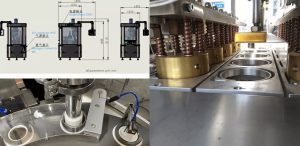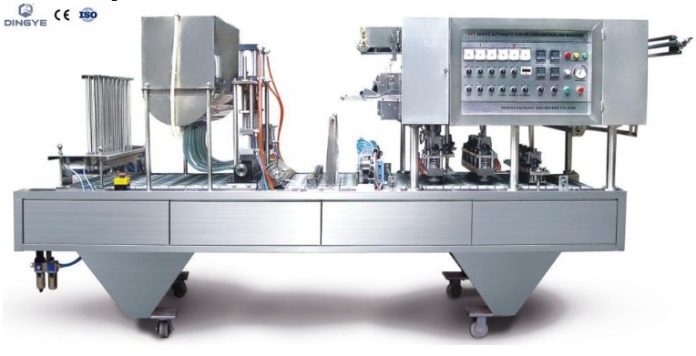Cup sealing machines are manufactured with top-quality materials and with the most advanced technology. It can seal 300-400 cups per hour, and it is easy to operate. They can be used to tea, milk, seal coffee, and other beverages. Once you place the cup in the holder, the machine will cut the plastic film according to the size of the cup. All of this will be done automatically by the machine.
Semi-automatic cup sealing machines: what are they?
Semi-automatic cup sealing machines are a type of cup sealing machine. The cup holder must be manually inserted into the machine.
Automatic cup sealing machines are often misused by companies. When the cup sealing machine is used incorrectly, it will not help the company complete its production more efficiently. The cup sealing machine’s service life will also be shortened. Let’s talk about how to use the cup sealing machine correctly.
There is almost no significant difference between automatic and semi-automatic cup sealing machines.
Automated cup sealing machines – what are they?
A computer-controlled automatic cup sealing machine seals cups automatically. Before using the sealing machine, push the cup holder into it. Afterwards, the cup can be automatically sealed.
The semi-automatic cup sealer: how does it work?
Connect the power supply to the semi-automatic cup sealing machine. To begin, turn on the power switch, the semi-automatic cup sealing machine’s indicator light should be on. Semi-automatic cup sealing machines automatically remove the lower mold slide plate. Our thermostat is set at a predetermined temperature, and the green heating indicator light is on. A red constant temperature indicator light will appear when the hot upper plate reaches the predetermined temperature. It is important to keep in mind that when the sealing machine is working, the electric heating device alternates between heating and maintaining heat. Semi-automatic cup sealing machines display alternate green and red indicator lights.
Insert the plastic cup into the lower mold slide and press the automatic control switch. The plastic cup must be manually pushed into the semi-automatic cup sealing machine. The button will be touched if you move a distance away from it. As soon as the signal is received, the upper mold of the semi-automatic cup sealing machine automatically presses down and fills. Pressing down for one second will be delayed by touching the switch. Upon completion, the automatic cup sealing machine will automatically rise and reset. Control the process on the computer if you need to repeat it later. Without manual control, the semi-automatic cup sealing machine can complete production automatically. It only takes a few minutes to place the items manually on the semi-automatic cup sealing machine if you want to repeat the operation.
Automatic cup sealing machine: how does it work?
The power switch must be turned on first when the device is in use. As soon as the indicator light inside the button lit up, we pressed the button. After that, adjust the speed of the automatic cup sealing machine. Cup sealing machines have an inner conveyor belt that can be adjusted for speed. In this way, production can be better coordinated. Next, adjust the temperature. The temperature needs to be raised. A temperature indicator on the automatic cup sealing machine will indicate when a certain temperature has been reached. The sealing operation can then be carried out.
Here is a brief introduction to this article. How easy is it to use the automatic cup sealing machine? Yes, that’s correct. Here are the steps to use the automatic cup sealing machine. Every step of the automatic cup sealing machine will have specific prompts due to its advanced and reasonable design. When using it, we only need to follow the prompts. As a result, the automatic cup sealing machine will operate more efficiently and quickly.
Further, reasonable use of the automatic cup sealing machine can extend its service life. Therefore, no matter what type of mechanical equipment we use, we must follow the correct use method in order to ensure its safety and longevity.

Common problems with cup sealing machines:
A cup sealing machine consists of a frame, a conveying device, and an electronic control system. When the package containing the items is placed on the conveyor belt, it works. During operation, the sealing part of the packaging bag is automatically fed between the two sealing belts. Bring it into the heating zone of the automatic cup sealing machine.
Through the sealing belt, heat is transferred from the heating block to the sealing part of the bag, melting and softening the film. As the packaging bag passes through the cooling zone of the automatic cup sealing machine, the film surface temperature drops appropriately. The upper and lower plastic films of the sealing part are then bonded by the printing wheel. Place the printed logo on the automatic cup sealing machine and press it down. After the sealed packaging bag is sealed, it is sent out of the device by the guiding rubber belt and the conveyor belt.
With the rapid development of food, medicine, and other industries, automatic sealing machines have also become increasingly popular. Industry markets continue to grow in scale. As a result of the fierce competition, automatic sealing machine manufacturers continue to innovate and upgrade their products. It is their goal to make equipment that is more beautiful, more efficient, easier to operate, and more convenient to maintain. Enhance customer development by bringing economic benefits. The device, however, still has some common faults that users need to address when using it.
1. Thermometer display malfunction
The fully automatic sealing machine is also fatally affected by this failure. The heat sealing temperature will not remain constant once the thermometer fails and cannot control the temperature. It is common for the sealing part of an automatic cup sealing machine to appear burnt or not tightly sealed. Therefore, the user should replace the heat sealing material, adjust the heat sealing pressure, and check the thermometer.
2. Improper sealing
One of the most common failures of automatic sealing machines is insufficient sealing. The failure can be attributed to three main reasons.
It cannot see the seal on the packaging bag, which is the first reason. Low heat sealing temperatures and too fast heat sealing speeds cause it. The packaging bags and plastic cups cannot be closed if the corona treatment is uneven. It is rare, but if it occurs, there is no other choice but to scrap the product. In order to resolve a quality problem quickly, it is necessary to analyze the cause. Imagine that moisture and dirt in the seal will also make the seal insecure. This failure situation can be resolved by appropriately increasing the heat sealing temperature, reducing the heat sealing speed, and increasing the pressure of the cold-pressed rubber wheel.
Additionally, even though the mouth of the packaging bag or plastic cup is sealed, a little harder squeezing or tearing will cause the seal to crack. Due to low heat-sealing temperatures and insufficient flatness of the knife surface, this situation occurs. By appropriately increasing the heat sealing temperature, the automatic cup sealing machine can fix the problem if the temperature is not enough. Make corresponding adjustments on the computer if the hot air knife surface of the automatic cup sealing machine is not neat enough.
In addition, half of the seal is firm when the peeling test is performed on it, and the other half is separated. In such packaging bags or plastic cups, the seals are still unqualified since the contents can easily leak out by squeezing them.
3. Poor contact of the sealing machine
It is necessary to check whether the shaft connection of the motor and the gearbox connection are loose or falling off due to the unstable operation of the sealing machine. These phenomena are signs that the carbon brushes of the engines need to be tightened and replaced if they occur when checking their wear.
In addition to understanding and mastering these three common faults and their corresponding solutions, users also need to pay attention to maintenance and maintenance during the shutdown of the equipment so that it can maintain a longer life and ensure the stable operation of production.



































